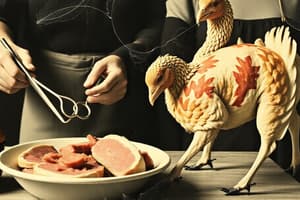Podcast
Questions and Answers
What is the primary goal of marinating food before cooking?
What is the primary goal of marinating food before cooking?
- To increase the cooking time
- To improve taste and tenderness (correct)
- To reduce the need for seasoning
- To prevent food from sticking to the pan
Which technique is classified as a moist heat cooking method?
Which technique is classified as a moist heat cooking method?
- Baking
- Sautéing
- Grilling
- Braising (correct)
Why is it important to use separate cutting boards for raw meats and vegetables?
Why is it important to use separate cutting boards for raw meats and vegetables?
- To prevent flavor contamination
- To avoid cross-contamination and foodborne illnesses (correct)
- To simplify the cleaning process
- To make food prep visually appealing
What is the purpose of measuring ingredients accurately during food preparation?
What is the purpose of measuring ingredients accurately during food preparation?
Which of the following is NOT a basic step in food preparation?
Which of the following is NOT a basic step in food preparation?
Flashcards are hidden until you start studying
Study Notes
Food Preparation
-
Definition: The process of preparing ingredients and meal components for cooking.
-
Basic Steps:
- Planning: Determine recipes and ingredients needed.
- Shopping: Purchase fresh, high-quality ingredients.
- Cleaning: Wash fruits, vegetables, and utensils to ensure hygiene.
- Measuring: Measure ingredients accurately for recipe consistency.
- Cutting: Use appropriate knives for chopping, dicing, and slicing.
-
Equipment:
- Cutting boards, knives, measuring cups, and spoons.
- Mixing bowls, pots, and pans for cooking.
- Food processors and blenders for preparation.
-
Safety:
- Keep surfaces and hands clean to prevent cross-contamination.
- Store perishable items at safe temperatures.
- Use separate cutting boards for raw meats and vegetables.
Culinary Techniques
-
Cooking Methods:
- Dry Heat: Techniques like baking, roasting, grilling, and sautéing.
- Moist Heat: Techniques such as boiling, steaming, and braising.
- Combination: Techniques like stewing and pressure cooking.
-
Preparation Techniques:
- Chopping: Cutting food into uniform pieces for even cooking.
- Sautéing: Quickly cooking food in a small amount of fat over high heat.
- Braising: Cooking food slowly in a small amount of liquid after browning.
- Poaching: Cooking food gently in simmering liquid.
-
Flavor Development:
- Seasoning: Use of herbs, spices, salt, and acidic ingredients to enhance flavor.
- Marinating: Soaking food in a flavorful liquid before cooking for improved taste.
-
Presentation:
- Importance of plating and garnishing for visual appeal.
- Techniques such as stacking, layering, and using sauces creatively.
-
Food Preservation Techniques:
- Canning: Sealing food in jars to extend shelf life.
- Freezing: Storing food at low temperatures to slow spoilage.
- Dehydrating: Removing moisture from food to prevent bacteria growth.
Food Preparation
- Involves making ingredients and meal components ready for cooking.
- Steps include:
- Planning: Choose recipes and gather necessary ingredients.
- Shopping: Opt for fresh and high-quality produce for better taste.
- Cleaning: Wash fruits, vegetables, and utensils to maintain hygiene standards.
- Measuring: Ensure accurate measurement of ingredients to achieve consistency in results.
- Cutting: Utilize a variety of knives for different cutting techniques like chopping and slicing.
- Essential equipment includes:
- Cutting boards, knives, measuring cups, and spoons.
- Cooking pots, pans, mixing bowls, food processors, and blenders.
- Safety precautions are vital:
- Maintain cleanliness of hands and surfaces to avoid cross-contamination.
- Store perishables at appropriate temperatures to prolong shelf-life.
- Use designated cutting boards for raw meat and vegetables to prevent contamination.
Culinary Techniques
- Cooking methods can be categorized as:
- Dry Heat: Involves baking, roasting, grilling, and sautéing for a crispy texture.
- Moist Heat: Includes boiling, steaming, and braising which retains moisture.
- Combination: Uses techniques like stewing and pressure cooking for rich flavors.
- Key preparation techniques include:
- Chopping: Ensures uniform food pieces for even cooking.
- Sautéing: Quick cooking technique using a minimal amount of fat over high heat.
- Braising: Slow cooking in liquid after initial browning for tender results.
- Poaching: Gentle cooking in simmering liquid to preserve texture and flavor.
- Flavor development through:
- Seasoning: Incorporating herbs, spices, and acidity to elevate dish flavors.
- Marinating: Enhancing taste by soaking ingredients in a flavorful liquid before cooking.
- Presentation techniques hold significance:
- Proper plating and garnishing enhance visual appeal.
- Creative stacking, layering, and sauce application can elevate the dining experience.
- Food preservation methods include:
- Canning: Airtight sealing of food in jars to prolong freshness.
- Freezing: Preventing spoilage by storing food at low temperatures.
- Dehydrating: Extraction of moisture to inhibit bacterial growth and spoilage.
Studying That Suits You
Use AI to generate personalized quizzes and flashcards to suit your learning preferences.



